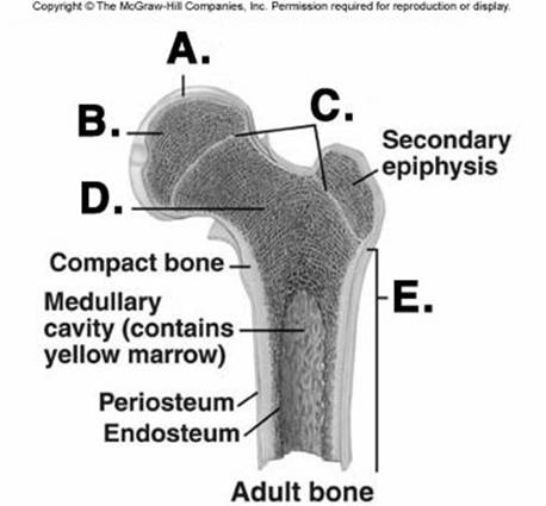A) spongy bone
B) compact bone
C) both spongy and compact
E) All of the above
Correct Answer

verified
Correct Answer
verified
Multiple Choice
 -What does structure "D" represent on the bone diagram?
-What does structure "D" represent on the bone diagram?
A) cancellous bone
B) diaphysis
C) epiphyseal lines
D) articular cartilage
E) epiphysis
G) C) and D)
Correct Answer

verified
Correct Answer
verified
Multiple Choice
Which of the following statements about bone remodeling and repair is correct?
A) Bone remodeling involves removal of old bone by osteoblasts.
B) As a long bone increases in diameter, the size of the marrow cavity decreases.
C) The rate of bone remodeling increases in the elderly.
D) Exposure of a bone to increased mechanical stress can lead to bone remodeling.
E) Bone remodeling does not involve the activity of the osteoclasts and the osteoblasts.
G) C) and D)
Correct Answer

verified
Correct Answer
verified
Multiple Choice
What is the site of long bone growth?
A) medullary cavity
B) periosteum
C) endosteum
D) diaphysis
E) epiphyseal plate
G) C) and D)
Correct Answer

verified
Correct Answer
verified
Multiple Choice
Which of the following is NOT a function of bone?
A) support
B) movement
C) immunity
D) calcium storage
E) blood cell formation
G) B) and D)
Correct Answer

verified
Correct Answer
verified
Multiple Choice
Chondroblasts produce
A) ligaments.
B) cartilage matrix.
C) bone tissue.
D) blood cells.
E) synovial fluid.
G) C) and D)
Correct Answer

verified
Correct Answer
verified
Multiple Choice
In appositional growth of cartilage,
A) chondroblasts within the tissue proliferate and add more matrix from the inside.
B) new chondrocytes and new matrix are added on the outside of the tissue.
C) osteoblasts replace the chondroblasts.
D) the tissue becomes vascularized in order to grow.
E) the cartilage is replaced with another kind of connective tissue.
G) C) and E)
Correct Answer

verified
Correct Answer
verified
Multiple Choice
Which of the following events occurs last?
A) Blood vessels grow into the primary ossification center.
B) Cartilage is calcified in the cartilage model.
C) A cartilage model is formed by chondroblasts.
D) Osteoblasts produce trabeculae and lamellae on the surface of calcified cartilage.
E) Secondary ossification centers appear in the epiphyses.
G) B) and E)
Correct Answer

verified
Correct Answer
verified
Multiple Choice
One effect of aging on the skeletal system is
A) decreased bone matrix.
B) increased bone density.
C) decreased collagen fibers.
D) increased elastic fibers.
E) Decreased bone matrix and decreased collagen fibers are effects of aging.
G) None of the above
Correct Answer

verified
Correct Answer
verified
Multiple Choice
Which type of bone appears porous?
A) spongy bone
B) compact bone
C) both spongy and compact
E) A) and B)
Correct Answer

verified
Correct Answer
verified
Multiple Choice
The stem cells of osteoblasts and chondroblasts are
A) osteocytes.
B) osteoclasts.
C) chondrocytes.
D) monocytes.
E) osteochondral progenitor cells.
G) None of the above
Correct Answer

verified
Correct Answer
verified
Multiple Choice
How does the urinary system contribute to osteoporosis?
A) Lack of exposure to sunlight reduces vitamin D production and decreases calcium absorption.
B) Immune cells resist infections and release chemicals that promote tissue repair.
C) Excessive smoking lowers estrogen levels, which increases bone loss.
D) Calcium ions released from the bones are excreted.
E) Decreased estrogen levels following menopause contribute to the disease.
G) C) and D)
Correct Answer

verified
Correct Answer
verified
Multiple Choice
Which type of bone is considered dense bone?
A) spongy bone
B) compact bone
C) both spongy and compact
E) A) and C)
Correct Answer

verified
Correct Answer
verified
Multiple Choice
The compression (weight-bearing) strength of bone matrix is due to the presence of
A) elastin fibers.
B) collagenase.
C) hydroxyapatite crystals.
D) collagen fibers.
E) bone marrow.
G) B) and E)
Correct Answer

verified
Correct Answer
verified
Multiple Choice
The processes of intramembranous and endochondral ossification are similar in several respects. Which of the following statements applies to both intramembranous and endochondral ossification?
A) Both processes form woven bone.
B) Both processes require a precursor of connective tissue membranes.
C) In both processes, bone replaces cartilage.
D) Both only form flat bones.
E) Chondrocytes participate in both processes.
G) A) and D)
Correct Answer

verified
Correct Answer
verified
Multiple Choice
The stem cells of osteoclasts are
A) osteocytes.
B) osteoclasts.
C) chondrocytes.
D) monocytes.
E) osteochondral progenitor cells.
G) A) and C)
Correct Answer

verified
Correct Answer
verified
Multiple Choice
 -What does structure "A" represent on the bone diagram?
-What does structure "A" represent on the bone diagram?
A) cancellous bone
B) diaphysis
C) epiphyseal lines
D) articular cartilage
E) epiphysis
G) A) and C)
Correct Answer

verified
Correct Answer
verified
Multiple Choice
Which of the following membranes covers the surface of a mature bone?
A) perimysium
B) perichondrium
C) peritendineum
D) peritoneum
E) periosteum
G) D) and E)
Correct Answer

verified
Correct Answer
verified
Multiple Choice
Intramembranous ossification
A) forms the bones of the roof of the skull.
B) is the process that produces most of the skeletal system.
C) occurs when bones develop from cartilage models.
D) occurs when osteoblasts invade the spaces left by dying cartilage cells.
E) occurs on the outer surface of the membrane.
G) A) and D)
Correct Answer

verified
Correct Answer
verified
Multiple Choice
How does the integumentary system contribute to osteoporosis?
A) Lack of exposure to sunlight reduces vitamin D production and decreases calcium absorption.
B) Immune cells resist infections and release chemicals that promote tissue repair.
C) Excessive smoking lowers estrogen levels, which increases bone loss.
D) Calcium ions released from the bones are excreted.
E) Decreased estrogen levels following menopause contribute to the disease.
G) B) and E)
Correct Answer

verified
Correct Answer
verified
Showing 101 - 120 of 150
Related Exams